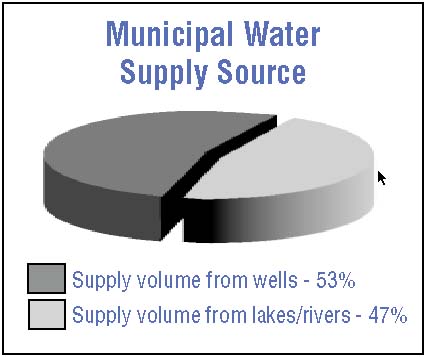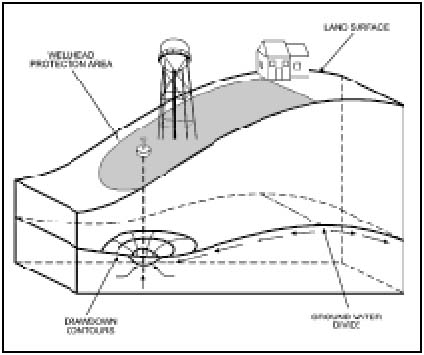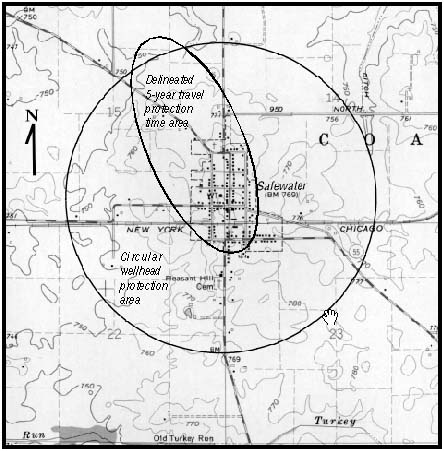
Larry Theller, Department of Agricultural and Biological
Engineering
Joe Yahner, Department of Agronomy
Jane R. Frankenberger, Department of Agricultural and Biological
Engineering
A recent Indiana wellhead protection rule, effective January 1, 1997, requires all public water supply systems using well water to produce a wellhead protection plan for areas around their wells. A wellhead protection plan offers a mechanism to protect a public water supply by managing the use of the land around the public well.
Ground water constantly moves through the earth toward wells. Wellhead protection is intended to prevent contamination which occurs on the land surface from reaching the ground water (well water) below by protecting the land surface above. This is done by setting up a zone around the well called a Wellhead Protection Area (WHPA). Within this area, any buildup, spill, or leak of materials that could contaminate the ground water (aquifer) is a concern. A management and education plan for the area lessens exposure to potential contaminants.
Because roughly 716 Indiana communities use well water as their drinking water source. Overall, cities and towns in Indiana obtain about half of their total drinking water supply from ground water (Figure 1). However, in many communities, well water is the only source of drinking water. Once ground water is contaminated it is very expensive to purify or replace.
Figure 1. The graph compares the amount of water supplied by public water systems from ground water and surface water sources.

Congress passed legislation to create the wellhead protection program to address this concern. Details on how to implement the program are left to individual states, with review and acceptance by the Environmental Protection Agency (EPA).
In Indiana, the Indiana Department of Environmental Management (IDEM) created a task force representing a wide range of commercial, public and regulatory organizations. The task force has been working for several years to create a wellhead protection rule which will be effective and also be manageable for the communities involved.
The Indiana Department of Environmental Management (IDEM) produced instructions to accompany the new rule in a publication called the Indiana Wellhead Protection Program.
The program protects water by the least expensive and safest method— prevention.
According to IDEM and the U.S. Environmental Protection Agency, the basic process includes several stages. Plans are submitted to IDEM for approval. For details see the official Wellhead Protection Program document or Purdue Extension publications describing the steps in detail (see back page).
Basic Steps in Wellhead Protection:
* Form a community-wide planning team.
* Delineate the size of the protection zone, based on the geology and pumping rates.
* Inventory potential sources of contamination.
* Create a management plan for the protection zone.
* Develop contingency plans for supply interruptions or spills.
* Plan for future water needs, and involve the public through education and outreach.
Each community’s approach (and each wellhead protection zone) will be different as they design plans to meet the needs specific to their community.
The planning team must coordinate with all the affected organizations, from the fire department to the corner gas station. The team should include a range of people with knowledge of the community and its water supply.
The wellhead protection area of a typical Indiana town may include several businesses, a residential neighborhood and perhaps a farm or golf course. The wellhead protection area may include area outside the town's borders or the utility's service area.
Since several jurisdictions (town board of works, county commissioners, etc.) will often be involved, negotiations involving various government and business entities may be required. Local business leaders, government and citizens must be included from the beginning. (For more information, see WQ-28, "Forming the Wellhead Protection Team.")
Figure 2. The delineation methods basically calculate the volume of an aquifer containing a five-ear water supply under current pumping and recharge rates. When mapped on the surface, this area becomes the wellhead protection area.

Determining the actual size of the wellhead protection area may involve simple or complex methods.
The wellhead protection area encloses the distance a drop of water will move toward the well from any direction in five years at present pump rates. The actual extent depends on several factors such as local geology, well capacity, and adjacent wells (Figure 2).
Very small systems may opt for using a 3000-foot radius circle around each well instead of using a computer model. Larger systems must use one of several forms of geological modeling to determine their wellhead protection area. Many water supply systems will employ consultants who use computer models, pump tests, and local geology to estimate the actual shape of the area. Figure 3 shows a comparison of these two methods.
Following delineation, the planning team will create an inventory of potential sources of contamination that exist within the wellhead protection area.
The area includes possible sources of both regulated and non-regulated chemicals. Historical uses (for example an unused heating oil tank or a former gas station) as well as current uses should be considered. Methods will range from "windshield surveys" and interviews with long-term residents to searches of various state and federal databases.
The public water supply operator maintains the inventory and incorporates removals or additions of potential sources. The state reviews the inventory every five years.
The completed inventory allows the planning team and the utility to structure the management plans to respond to actual threats to the water quality.
Figure 3. This diagram compares a computer modeled wellhead protection area with a 3000 foot radius. Lower beginning costs associated with the circle wellhead protection area may be offset by higher long-term management costs.

The success of the wellhead protection program depends upon the creation of an effective management plan. The term "manage" can include many different aspects when applied to the various uses of land inside a wellhead protection area.
The least expensive and safest method of controlling surface contamination is prevention. Prevention begins by applying existing regulations and educating about safe handling of all chemicals.
The local planning team might propose education programs on Best Management Practices (BMPs) or chemical safety and disposal regulations for businesses or residents inside the wellhead protection area.
The team might suggest that the local government adopt water quality monitoring, high-risk business licensing, or overlay zoning on particular land uses for the area -- a two-phase process.
As the local wellhead protection plan takes shape, it becomes a good time for the whole community to look ahead.
The finished and approved Wellhead Protection Plan will contain a public outreach program, emergency contingency plans, an ongoing potential contaminant inventory, and an ongoing management effort.
The information provided in this program can be a valuable tool for planning the direction of future development, both of the community and of the water supply.
* Safe Water for the Future is a Purdue Extension program that provides education, including this and other publications on wellhead protection. Call 765-496-6331 or visit: (http://www.ecn.purdue.edu/SafeWater).
Information is available from IDEM about Indiana's Wellhead Protection Program.
* Call 317-308-3326 or visit the IDEM Web site at . (http://www.in.gov/idem/programs/water/swp/whpp/)
Follow the link to wellhead protection for this information and to access the application needed to file a wellhead protection plan.
* The EPA Safe Drinking Water Hotline [800-427-4791] is available to help state and local officials and the public answer questions about drinking water. The hotline also has information about the National Rural Water Association's program to assist small communities develop local drinking water protection plans.
The following Purdue Extension publications provide information about other aspects of the wellhead protection process.
* WQ-2, "What Is Groundwater?"
* WQ-22, "Indiana Farmstead Assessment for Drinking Water Protection"
* WQ-25, "Home *A* Syst: An Environmental Risk Assessment for the Home"
* WQ-28, "Forming the Wellhead Protection Planning Team"
* WQ-29, "Delineating the Wellhead Protection Area: A Shortcut for Some Systems"
* WQ-30, "Choosing a Consultant to Delineate the Wellhead Protection Area"
* WQ-31, "Inventorying Potential Sources of Drinking Water Contamination"
* "Protecting Your Drinking Water: What Every Citizen Should Know About Wellhead Protection" (publication number 7-20) and "Wellhead Protection: What Every Farmer Should Know About Wellhead Protection" (publication number 7-19). These short brochures may be useful in your outreach efforts.
All these publications are free. Contact your local county Purdue Extension office, or call 1-888-EXT-INFO to obtain these or other publications.
The USEPA has an informative publication, "Wellhead Protection, A Guide for Small Communities," EPA/625/R-93/002, available free by calling 1-800-490-9198.
It is the policy of the Purdue University Cooperative Extension Service, David C. Petritz, Director, that all persons shall have equal opportunity and access to its programs and facilities without regard to race, color, sex, religion, national origin, age, or disability. Purdue University is an Affirmative Action employer.
This material may be available in alternative formats.
1-888-EXT-INFO